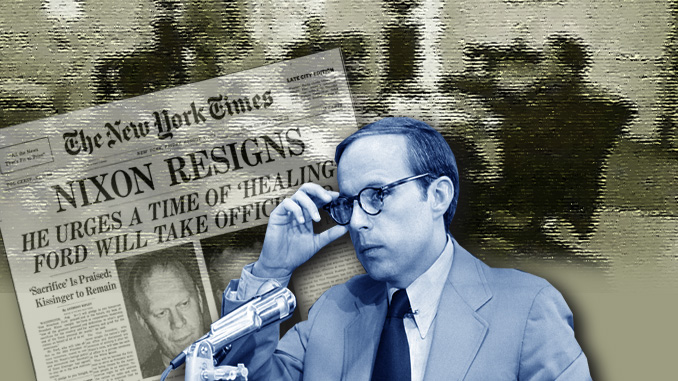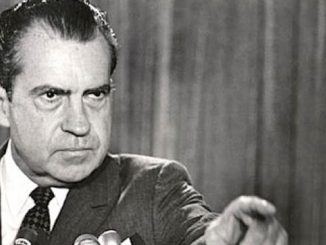
Some researchers believe John Dean and his wife hold the key to the real reasons for the 1972 Watergate break-in.
By S.T. Patrick
Forty-five years after the two Watergate break-ins of June 1972, researchers are still tangling over who ordered the break-ins and why. Since 1984, revisionists have researched and formulated a theory that has changed how skeptical students of Watergate view the scandal that forced the resignation of Richard Nixon.
At a Hofstra University speech in 1987, former Nixon Chief of Staff H.R. Haldeman summarized the conventional wisdom among reflective Nixon-era conservatives. “To this day I still don’t know why that was done,” Haldeman said, “and I don’t know anybody who does. Why they would hit the (Democratic) National Headquarters is beyond me, because nobody in that place knows anything anyway.”
At the same symposium, Jeb Magruder, former deputy director of the Committee for the Re-Election of the President (CREEP), pushed the Hughes-Rebozo theory for the break-ins. Multimillionaire Howard Hughes, the theory states, gave $100,000 to Nixon’s close friend Bebe Rebozo. The money was then used by the Nixon family, in part for furniture and jewelry. The break-ins were executed to find out what information DNC chairman Lawrence O’Brien may have had about the Hughes-Rebozo transaction, as well as to gather damaging information that may persuade O’Brien to withhold the information throughout the 1972 campaign.
Since the 1980s, a team of revisionist historians and researchers have developed a theory that puts former White House Counsel John Dean in the crosshairs of the Watergate debacle. And though Sen. Howard Baker (R-Tenn.) famously asked Dean what Nixon knew about Watergate and when he knew it, researchers now believe that the key to understanding the break-ins themselves lies with Dean, his wife Maureen, and Magruder.
Author Phil Stanford wrote White House Call Girl: The Real Watergate Story to detail the life of Heidi Rikan, who ran a call-girl operation at the luxurious Columbia Plaza Apartments, blocks from the Watergate complex. Stanford’s work built on and expanded the research of Jim Hougan’s Secret Agenda: Watergate, Deep Throat, and the CIA and Len Colodny and Robert Gettlin’s Silent Coup: The Removal of a President.
Ms. Rikan had gathered a crop of women new to the Beltway to entertain Democrat politicians in town on business. Typical for Washington, D.C. prostitution rings of the era, the Columbia Plaza setup was an intelligence-gathering operation that would be used for potential blackmail and political advantage. Private eye Lou Russell served as security for Rikan at the apartments and has admitted tape-recording telephone conversations between Ms. Rikan’s girls and their clients at the DNC.
One of the Watergate burglars was found with a key belonging to the desk of secretary Ida “Maxie” Wells, the DNC contact who historians believe allegedly instigated the liaisons and whose desk may have contained the real names of the johns that had used Ms. Rikan’s service.
Stanford found witnesses who tied Maureen (Kane) Biner to Ms. Rikan. “Mo” Biner would later date and then marry Dean. Arguably the most interesting pieces of evidence in the case are Ms. Rikan’s little black books. Unearthed by Ms. Rikan’s sister, the little black books contain the names of politicians, dignitaries, and athletes. Interestingly, one book contains home addresses and phone numbers for Maureen Kane and her mother, Irene. A later version of Ms. Rikan’s black book contains both home and office numbers for the Deans, as well as John Dean’s number at the White House.
Speculation has existed as to the nature of Maureen’s involvement with Ms. Rikan’s operation. Stanford confirmed to this writer that Ms. Rikan and Maureen were friends who partied and traveled together. In White House Call Girl he alludes to testimony from various sources that Maureen had been a high-level prostitute, but he denies having documented evidence.
According to Ms. Rikan’s attorney, Phil Bailley, Magruder was seeing “Candy Cane,” one of Ms. Rikan’s prostitutes. As Bailley was walking toward Cane’s apartment one day, he saw a dark-haired man get into a chauffeured black sedan. When Bailley asked who the man was, Cane responded, “You weren’t supposed to see that. That’s the boss of bosses.”
Bailley later identified the man with Cane as Magruder, whose home phone number was also found in Rikan’s books.
Revisionist historians were not alone in doubting Magruder’s Hughes-Rebozo theory for the Watergate motive. Charles Colson, the former presidential counsel, told The New York Times that he was almost knocked off his chair when Magruder made the accusation at Hofstra.
Colson once embraced Magruder in a hallway as they served time together in federal prison. Colson wanted real answers to the “what” and “why” questions of the break-ins.
“What were we doing at the Watergate, Jeb?” Colson asked Magruder. “(Magruder) turned white as a sheet and wouldn’t tell me. Later, on the outside, I asked him again. Still he wouldn’t say.”
Magruder did eventually tell author Len Colodny that Dean ordered the break-ins. G. Gordon Liddy had also affirmed Dean’s involvement in testimony given when Ida Wells unsuccessfully sued him for statements he had made about her involvement.
The Fourth Circuit Court of Appeals summarized Liddy’s testimony: “Liddy stated that the burglars’ objective during the Watergate break-in was to determine whether the Democrats possessed information embarrassing to John Dean.”

Magruder, like Colson, would turn to the ministry after leaving prison. He was a Presbyterian minister from 1981 through his death in 2014.
John and Maureen Dean have spent decades defending their side of the Watergate story. Most notably, they sued Colodny. The case was settled out of court and terms were not released. Both parties claim victory to this day. The Deans have denied a close relationship with Ms. Rikan, they have denied that Ms. Rikan ran a call-girl ring, and they deny that the motive for the Watergate break-ins had anything to do with their relationship.
Dean frequently writes about political scandal, predictably comparing each scandal to Watergate and each president to Nixon. Dean’s cooperation with prosecutors on Watergate aided the indictments of administration officials who had once trusted him. To revisionist historians who continue to challenge the accepted view of Watergate, both Dean and Magruder had links to Ms. Rikan’s operation that had to be extracted from the DNC offices.
The near-unanimous opinion of former Nixon appointees is that Dean is a self-serving traitor. To media outlets such as MSNBC that hire him for political commentary to this day, he is the hero who brought down Nixon.
S.T. Patrick holds degrees in both journalism and social studies education. He spent 10 years as a respected educator and now hosts the “Midnight Writer News Show.” You may email him at [email protected].
This article was originally published in American Free Press Issue 1 & 2, January 1 & 8, 2018.




